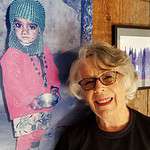
By Marilyn Karr
We drove for a few minutes to Institute, a fork in the road, to see if we could find the old farmhouse, Roman Catholic boarding school, tavern, church and graveyard.
Immediately, we found the church and graveyard with my great great grandfather’s tall gravestone. The Catholic boarding school no longer existed, but Dad told me stories of the nuns and their strict discipline.
Then, I learn the church, St. Peter & Paul Catholic Church, was originally the boarding school.
St. Aloysius, the boarding school, was completed in 1892. Built to accommodate 40 boarders, the school consisted of dormitories, play room, sewing classrooms and chapel. It cost $4 per month to reside. The people of Institute regularly collected food for the institution.
Besides local children, children boarders from as far away as Milwaukee, Chicago and Michigan kept the school filled to capacity. Some children were orphans or semi-orphans whose mother or father wanted the child to have a Catholic education. Many parents brought their children there on Monday and picked them up on Friday.
Before rural mail delivery, the Sisters at the boarding school had charge of the local post office.
We drove up the dirt driveway and could see where the homestead stood, the barn’s rock foundation, a water pump and a few rusty implements.

Hocks Saloon still stands on the property as shown on the aged plat map. My great great grandfather built the first building in Institute. There was a dance hall and a saloon on the second floor with living quarters on the first floor. He also built a barn for dance patrons’ and church members’ horses. One of the renters was my great grandfather.
My great great grandfather sold the 160 acres to his son, my great grandfather, who sold it to his son, minus six acres for the newly-built Highway 57 on the corner of the property. The personal property taxes in 1861 was 18 cents.
What a full day! By this time, I’m mentally and physically exhausted and Dad is going strong even though it’s 11 p.m.
Sometimes, he thought we were in Sherman County (Oregon), Washington or the Atlantic Ocean. He asked numerous times if we were driving home.
We traveled the whole peninsula and visited the numerous parks. Hopefully, some day I can trek part of the 1,000 mile pathway of the Ice Age Trail which follows the path of the ancient glacier.
One night dad got up to go to the toilet. Now, he knows just how many steps it is to get back to bed. Yep, he crawled into another bed for the night. Thankfully, no one was sleeping there at the time.
One day we drove to Algoma. Immediately, Dad recognized the name of the town and said, “My mother had a friend or a sister who lived around here.” I locate the cemetery to see if we could find any relatives’ tombstones. It was Sunday and the office was closed. Even though Dad suffered from dementia, something clicked for him – whether it was a feeling he had or road sign, I’ll never know. Many years later, he gave me a framed picture of his father. On the back was a death notice of my grandmother’s sister, who lived in Algoma.

While in Algoma, we visited the Von Stiel Winery, Wisconsin’s oldest licensed winery. Originally owned by Dr. Charles Von Stiel, an orthopedic surgeon, bottles were cast with plaster of paris.
Then we spent the afternoon at the local park festivities and ate our first Wisconsin bratwurst sandwich. A local food that we found was great!
During our last day, we visited the Maritime Museum in Green Bay. It had an excellent display of the ships that were wrecked by ice crushing them or by their hitting the shore line. When we entered the museum, we signed in a book and gave a contribution. An elderly gentleman asked if Dad is related to Peter Hocks. Peter was my Dad’s uncle who married my grandmother’s sister. If you think you are confused, please know that I am, as well.
Peter Hocks had a vessel that was made there at the shipbuilding company. The last we heard, it was still being used either out of Milwaukee or in one of the Great Lakes.
There are no words to describe the sites and history of the Door County peninsula. A place where ships were wood and men were iron. The ships, the limestone quarries, wooden passenger steamers, stone barges, the men who marched off to the Civil War, the Door County Fish Boil.
I only got a smattering introduction, but I think you present-day explorers would find a myriad of unfathomable adventure at Door County.
We arrived home a little later than we had planned. As late as it was, Dad was still going strong. He suggested we stop and get something to eat.
My Dad was not only my Dad, but my best friend for years and years; and on that journey with so many facets of life, I learned what unconditional love is. Dad, you gave me the courage to be myself, to like myself and to accept others for who they are.
Thank you. I love you, Your daughter, Marilyn
Here’s a link to Journey Gal – Search for Roots Part 1


